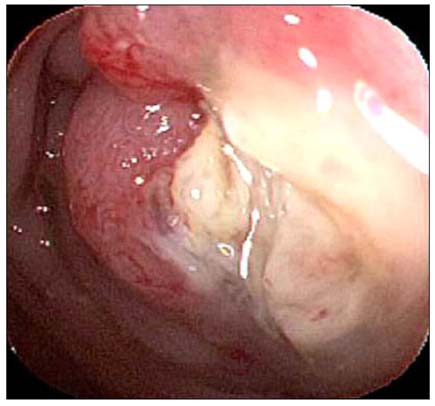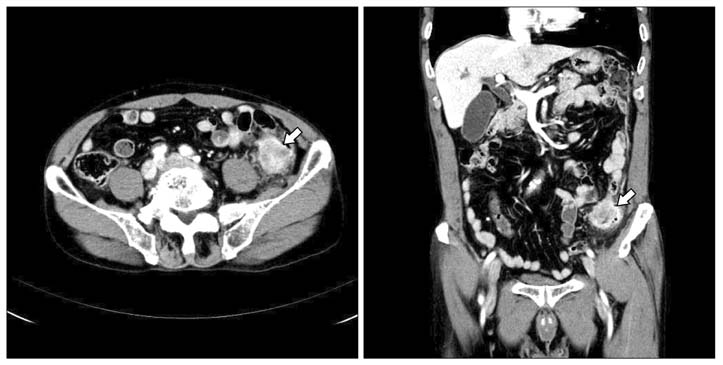J Korean Surg Soc.
2011 Jun;80(Suppl 1):S31-S35. 10.4174/jkss.2011.80.Suppl1.S31.
Primary adenosquamous carcinoma of the colon
- Affiliations
-
- 1Department of Surgery, Digestive Disease Research Institute, Wonkwang University College of Medicine, Iksan, Korea. east1st@wku.ac.kr
- 2Department of Pathology, Digestive Disease Research Institute, Wonkwang University College of Medicine, Iksan, Korea.
- KMID: 2096646
- DOI: http://doi.org/10.4174/jkss.2011.80.Suppl1.S31
Abstract
- Adenosquamous cell carcinoma (Ad-SCC) of the colon is rare. The pathogenesis of Ad-SCC is unclear, however, several hypotheses have been suggested. The clinical presentation and gross findings of Ad-SCC of the colon are similar to those of adenocarcinoma of the colon, but Ad-SCC has a more aggressive clinical course and a poorer prognosis. We report on two cases of Ad-SCC of the colon with obstruction; a collision-type Ad-SCC that has not only obstruction but also numerous hepatic metastases, and a composite-type Ad-SCC treated with left hemicolectomy followed by an adjuvant chemotherapy.
MeSH Terms
Figure
Reference
-
1. Cagir B, Nagy MW, Topham A, Rakinic J, Fry RD. Adenosquamous carcinoma of the colon, rectum, and anus: epidemiology, distribution, and survival characteristics. Dis Colon Rectum. 1999. 42:258–263.2. Frizelle FA, Hobday KS, Batts KP, Nelson H. Adenosquamous and squamous carcinoma of the colon and upper rectum: a clinical and histopathologic study. Dis Colon Rectum. 2001. 44:341–346.3. Nozoe T, Anai H. Adenosquamous carcinoma of the sigmoid colon: report of a case. Surg Today. 2001. 31:830–832.4. Dong Y, Wang J, Ma H, Zhou H, Lu G, Zhou X. Primary adenosquamous carcinoma of the colon: report of five cases. Surg Today. 2009. 39:619–623.5. Kim KH, Han SM, An CH, Kim JS, Yoo SJ, Chae HS, et al. A case of adenosquamous carcinoma of the cecum. J Korean Soc Coloproctol. 2000. 16:204–208.6. Levendoglu H, Cox CA, Nadimpalli V. Composite (adenocarcinoid) tumors of the gastrointestinal tract. Dig Dis Sci. 1990. 35:519–525.7. Fukui H, Takada M, Chiba T, Kashiwagi R, Sakane M, Tabata F, et al. Concurrent occurrence of gastric adenocarcinoma and duodenal neuroendocrine cell carcinoma: a composite tumour or collision tumours? Gut. 2001. 48:853–856.8. Herxheimer G. Ober heterologue cancroide. Beitr Pathol Anat. 1907. 41:348–412.9. Schneider TA 2nd, Birkett DH, Vernava AM 3rd. Primary adenosquamous and squamous cell carcinoma of the colon and rectum. Int J Colorectal Dis. 1992. 7:144–147.10. Petrelli NJ, Valle AA, Weber TK, Rodriguez-Bigas M. Adenosquamous carcinoma of the colon and rectum. Dis Colon Rectum. 1996. 39:1265–1268.
- Full Text Links
- Actions
-
Cited
- CITED
-
- Close
- Share
- Similar articles
-
- Adenosquamous Carcinoma of the Ascending Colon: A Case Report and Review of the Literature
- Adenosquamous Carcinoma in Distal Transverse Colon in a 72-Year-Old Female Patient
- An adenosquamous carcinoma of the liver that developed metachronously in a patient with a colon adenocarcinoma
- A Case of Cutaneous Metastatic Adenosquamous Carcinoma of the Pancreas
- Primary Adenosquamous Carcinoma of Jejunum







